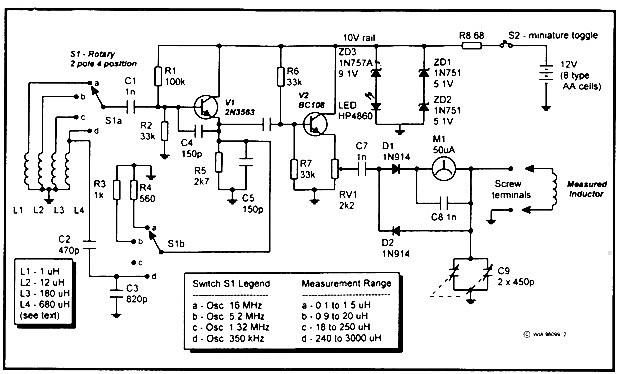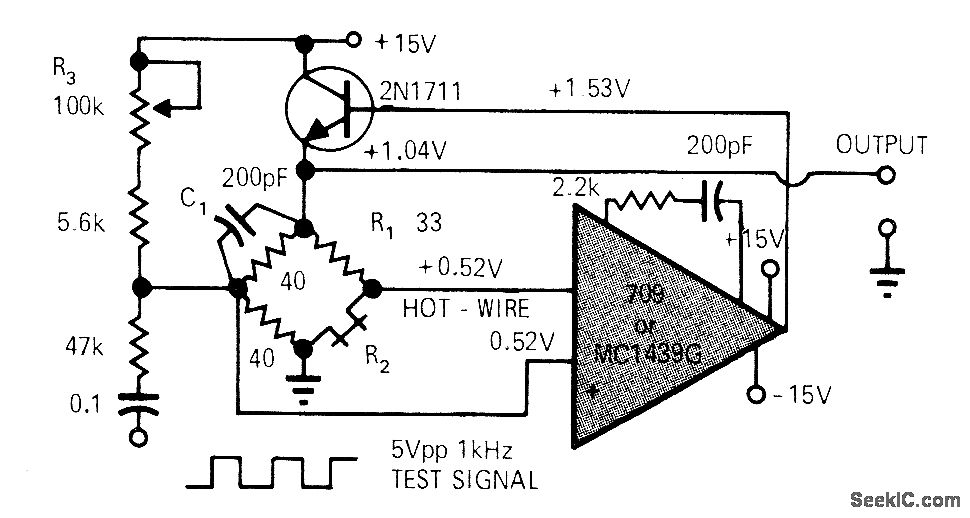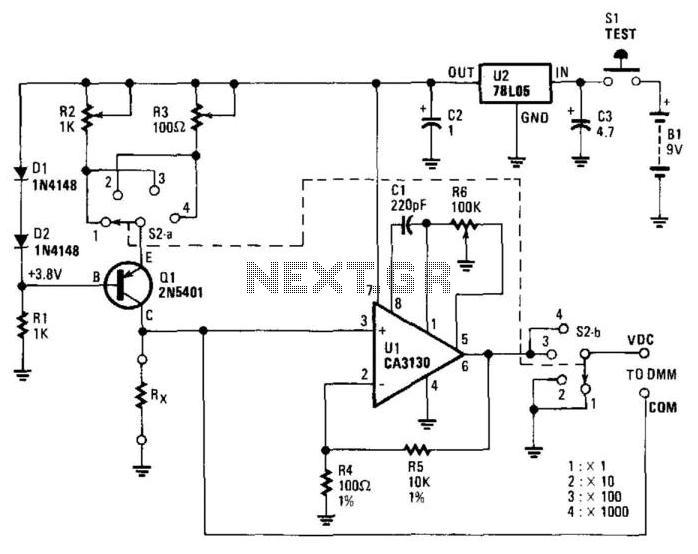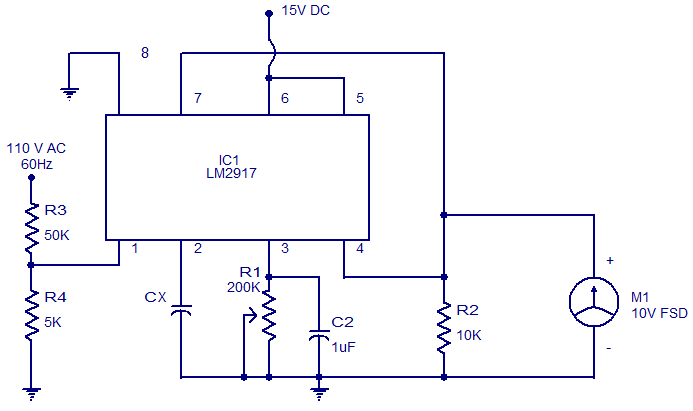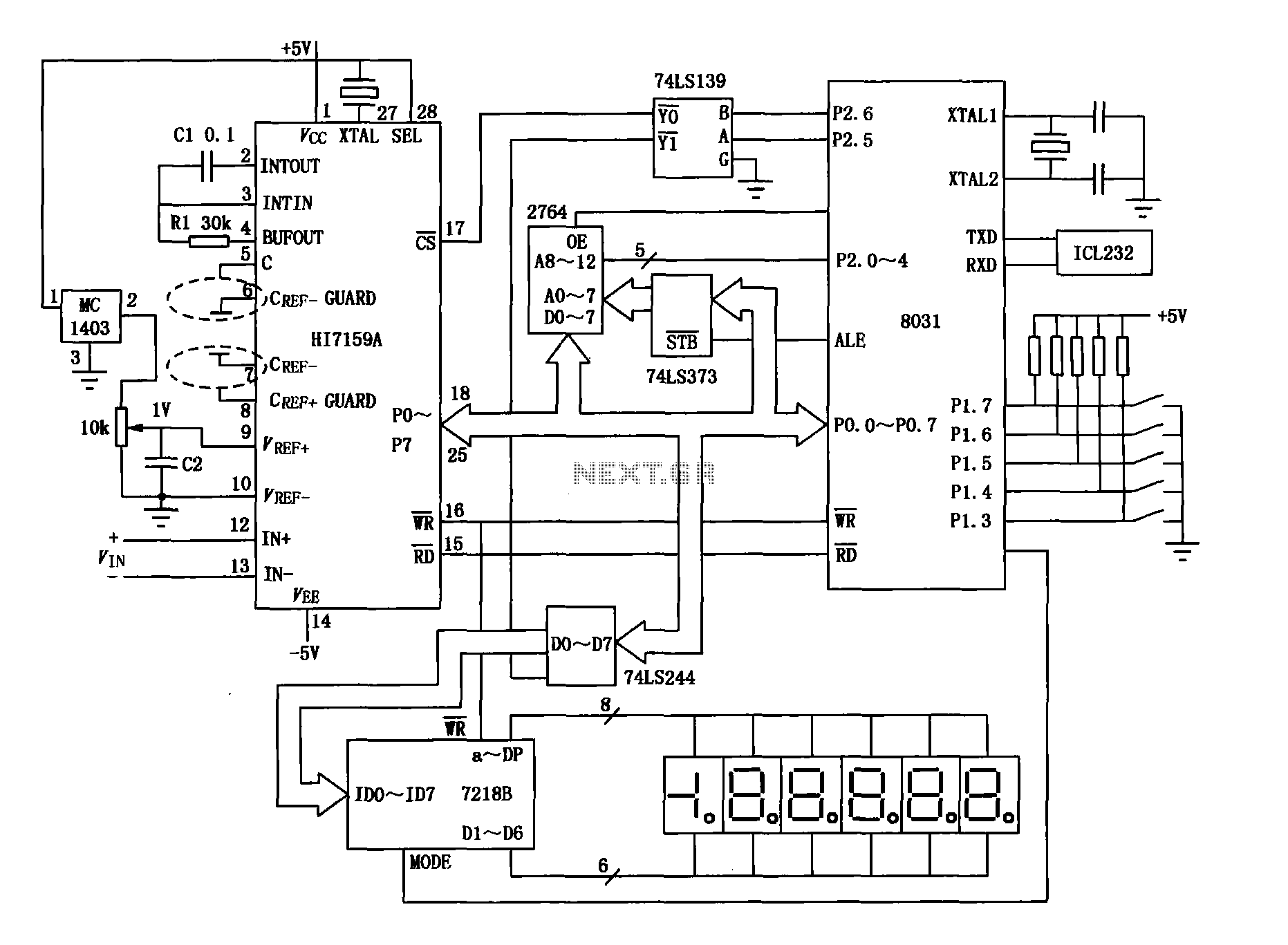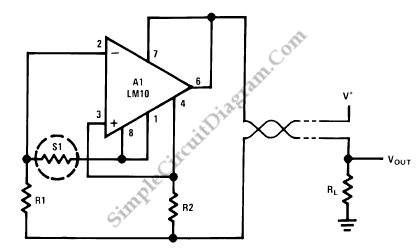
Analogue Ohm meter
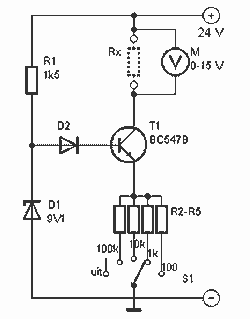
This is a simple ohm meter that is small to build. The circuit operates with a constant current around T1. The current depends on the emitter through S1 can be chosen. These are the ranges of the meter. The constant current through T1 causes a voltage drop across Rx, the measured resistance. This voltage is measured by M. D2 is a germanium diode. You can try a 90 or OA 118 using AA. The resistance value is the range times the meter reading in volts. More: R1 = 1.5 kOhm R2 = 820 kOhm R3 = 82 kOhm R4 = 8.2 kOhm R5 = 820 ? D1 = 9.1 V zener D2 = germanium diode T1 = BC 547B M = meter 0-15 V
The described circuit functions as a simple ohm meter, designed for ease of construction and operation. The core of the circuit is a transistor (T1), specifically a BC 547B, which operates in a constant current mode. The current flowing through T1 is adjustable by selecting different emitter resistors through switch S1, allowing the user to choose between different measurement ranges.
The circuit employs a resistor (Rx) across which the resistance to be measured is connected. The constant current flowing through T1 generates a voltage drop across Rx, which is proportional to the resistance value according to Ohm's Law (V = I * R). This voltage drop is then measured by a meter (M), which is calibrated to read from 0 to 15 volts. The output reading on the meter directly correlates to the resistance value, which can be calculated as the resistance range multiplied by the meter reading in volts.
The circuit also includes several resistors (R1, R2, R3, R4, and R5) with specific values that help set the current levels and ensure proper operation across the chosen measurement ranges. R1 is a 1.5 kOhm resistor, R2 is an 820 kOhm resistor, R3 is an 82 kOhm resistor, R4 is an 8.2 kOhm resistor, and R5 is an unspecified value of 820 Ohms, which may serve as a load or part of the current limiting setup.
Diode D1, a 9.1 V zener diode, is used to provide voltage regulation within the circuit, ensuring that the voltage supply remains stable for accurate measurements. D2 is a germanium diode, which can be replaced with alternatives such as a 90 or OA 118, and it plays a role in the circuit's overall functionality, likely in protecting against reverse polarity or in signal conditioning.
Overall, this simple ohm meter circuit is effective for measuring resistance values in a compact form, with the added flexibility of range selection through the use of different emitter resistors.This is a simple ohm meter that is small to build. The circuit operates with a constant current around T1. The current depends on the emitter through S1 can be chosen. These are the ranges of the meter. The constant current through T1 causes a voltage drop across Rx, the measured resistance. This voltage is measured by M. D2 is a germanium diode. You can try a 90 or OA 118 using AA. The resistance value is the range times the meter reading in volts. R1 = 1.5 kOhm R2 = 820 kOhm R3 = 82 kOhm R4 = 8.2 kOhm R5 = 820 ? D1 = 9.1 V zener D2 = germanium diode T1 = BC 547B M = meter 0-15 V 🔗 External reference
The described circuit functions as a simple ohm meter, designed for ease of construction and operation. The core of the circuit is a transistor (T1), specifically a BC 547B, which operates in a constant current mode. The current flowing through T1 is adjustable by selecting different emitter resistors through switch S1, allowing the user to choose between different measurement ranges.
The circuit employs a resistor (Rx) across which the resistance to be measured is connected. The constant current flowing through T1 generates a voltage drop across Rx, which is proportional to the resistance value according to Ohm's Law (V = I * R). This voltage drop is then measured by a meter (M), which is calibrated to read from 0 to 15 volts. The output reading on the meter directly correlates to the resistance value, which can be calculated as the resistance range multiplied by the meter reading in volts.
The circuit also includes several resistors (R1, R2, R3, R4, and R5) with specific values that help set the current levels and ensure proper operation across the chosen measurement ranges. R1 is a 1.5 kOhm resistor, R2 is an 820 kOhm resistor, R3 is an 82 kOhm resistor, R4 is an 8.2 kOhm resistor, and R5 is an unspecified value of 820 Ohms, which may serve as a load or part of the current limiting setup.
Diode D1, a 9.1 V zener diode, is used to provide voltage regulation within the circuit, ensuring that the voltage supply remains stable for accurate measurements. D2 is a germanium diode, which can be replaced with alternatives such as a 90 or OA 118, and it plays a role in the circuit's overall functionality, likely in protecting against reverse polarity or in signal conditioning.
Overall, this simple ohm meter circuit is effective for measuring resistance values in a compact form, with the added flexibility of range selection through the use of different emitter resistors.This is a simple ohm meter that is small to build. The circuit operates with a constant current around T1. The current depends on the emitter through S1 can be chosen. These are the ranges of the meter. The constant current through T1 causes a voltage drop across Rx, the measured resistance. This voltage is measured by M. D2 is a germanium diode. You can try a 90 or OA 118 using AA. The resistance value is the range times the meter reading in volts. R1 = 1.5 kOhm R2 = 820 kOhm R3 = 82 kOhm R4 = 8.2 kOhm R5 = 820 ? D1 = 9.1 V zener D2 = germanium diode T1 = BC 547B M = meter 0-15 V 🔗 External reference
